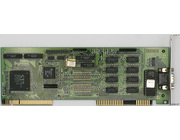This oddball has a PCI-connector but uses the S3 86C805-P chip that is an evolution of the original 86C805 ISA-chip. The 86C805-P chip is connected to the PCI bus using a LA2158 bridge! Who thought that was a good idea? ![]()
Nevertheless this is an interesting card in the benchmarks. I don't have a true ISA or VLB 86C805-P-based card at the moment so I can't do direct comparisons, but considering the success of the Tseng Labs ET4000 (see the Diamond SpeedSTAR 24 for instance) this bridged miroCRYSTAL 10SD isn't so bad after all. It's nowhere compared to the newer chips but it's clearly visible that the PCI-bus is able to give the old ISA-chip a huge boost. Actually, the text-based and VGA-based applications aren't so bad but when SVGA kicks in it's a different story.
And did you look at the Syschk benchmark? The benchmark pushes some ASCII text around and does did job extremely fast. Especially considering it's an ISA chip underneath.
In summary: this card is not suitable to provide that "period-correct performance" in a 486 PCI or early Pentium system. Any true S3 based PCI-card is clearly a better choice. However, I do like the card for being something different than usual and it works better than I initially thought it would do.
One remark on being true ISA or PCI: the 86C805-P chip is supposed to be the PCI-version of the 86C805, yet it still needs a bridge chip to connect to the PCI-bus. In that regard I think that cards with the 86C928P or Vision-chipsets are the first true PCI-chips. > Read more



